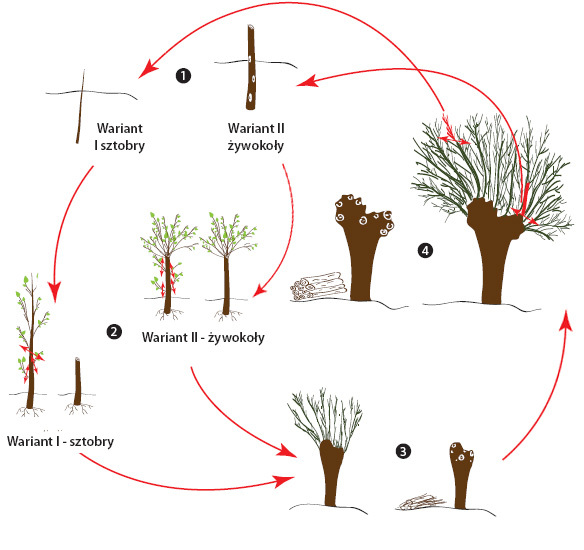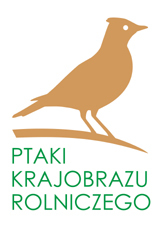Protect the headed willows
Willows have always been an element of the Polish landscape, especially the so-called headed willows, with their crowns shaped like heads. Their presence and appearance was created by people, because they have been very useful for them for many centuries.
People have been making life fences from them, which did not have to be replaced over time, as they did not rot in the ground. You only had to cut the branches from the crown of the willow and plant them in the early spring or autumn in the ground, so they could root and grow. This way, people have created alleys of those trees that grew fast and after cutting them above 2 meters, they were creating new headed willows. Thick branches of many years were cut and used as firewood. The thinner ones were used to weave baskets.
Headed willows are a real shelter of the nature. They grow fast, and when regularly pollarded, their trunks become thicker. Willow wood is soft, and is appreciated by woodpeckers (most often green), who, after few years of willow’s life, create their hollows in them. After woodpeckers, the hollows are often occupied by rare little owls, hoopoes, sparrows, tree sparrows, tits and many other hole-nesting bird species.
Even ducks make their nests in the crown of the headed willow. During early spring, when the willow is blossoming, many pollinating insects fly in – mostly bees and bumblebees. The presence of willows in the landscape determines the presence of all those rare animals. That’s why we have to take good care of the willows – pollard the old ones and plant new ones.
But how do we do that? We may choose one of two options.
Option I – canes.
Willows easily reproduce from lignified unrooted planting material (canes) – a piece of branch of around 30 cm in length, planted directly into the ground in autumn or early spring. After rooting and sprouting, the young plant is maintained in a tree form with one trunk, until it reaches the thickness of 5 cm at the height of 2 cm. Usually, it takes a few years. After reaching this thickness, in the spring we cut the top and the side shoots. The rooted tree needs to be pollarded every year or every 2 years for the next 10 years, all shoots cut at the top. After the 10th year, the willows need to be pollarded every 5 years or so.
Option II – stems
On a terrain with high level of ground water, we plant thick willow shoots of 5-10 cm in diameter and 1.5-2.5 m in length (depending on the needs). The branches are collected from older trees during winter, and planted in March/April after the soil has thawed. We plant them in the loosened soil, as deep as we can. In the year of planting, the shoots that are sticking from the trunk are cut. Only the ones that are on top are left and we need to make sure the tree has enough water in the event of draught. The rooted tree needs to be pollarded every year or every 2 years for the next 10 years, all shoots cut at the top. After the 10th year, the willows need to be pollarded every 5 years or so.
Pollarding has to be done while the trees are in their dormant period, that is from November until the end of February.
We are trying to promote, among other, such traditional methods of protecting the landscape by executing the educational project called “Fields full of life” mostly for those, on whom the nature depends to survive – farmers, children and teenagers. We invite you to visit our website: pola.bocian.org.pl, there you can get familiar with this year’s schedule of the Headed Willow Days, which are organized every year by the Association.

Fields full of life
Many people know that every fourth stork is Polish. But how many people know that similar case is also with skylarks and yellow wagtails? That’s right, in many places of the Western Europe skylarks are an endangered species!
Why do those species find Poland so attractive? Mostly thanks to the Polish extensive farming. Because of it, the landscape of our villages is very diverse, which results in good living conditions for many animals and plants.
In order to make the residents aware of the big value that the nature of an agricultural landscape has, especially when compared to other European countries, the “Bocian” Nature Society executes an educational project called “Fields full of life – an educational campaign for protecting the biological diversity in the agricultural landscape”. Thanks to these activities, we want to show the beauty and diversity of the landscape, make the recipient interested in the biology of the species living on farming areas and show ways of farming that are harmless to the nature. The target group consists of the residents of agricultural areas of the Eastern Poland – mostly school-going children and farmers from the Mazovian, Warmian-Mazurian, Podlaskie, Świętokrzyskie and Lubelskie voivodeships.
Activities are carried out by local coordinators in 30 poviats. Their task is to organize screening of a specially directed movie about the nature of the agricultural landscape, provide training for teachers, lectures at schools (using educational resources prepared especially for this program) or to participate in local events.
There is a travelling professional photography exhibition presenting the nature, and in winter, there will be activities organised, connected with pollarding of willows.
We assume that because of conducting such diverse educational activities, we will be able to reach a vast group of recipients, make them interested in the nature of the Polish village, make them aware that they have an influence on the survival of species that are already getting extinct in the Western Europe, due to extensive agriculture. We hope that the increase of awareness will reflect in the change of the attitude and in the actions: it will encourage farmers to take better care of elements of the landscape that are of high natural value and to participate in agricultural and environmental programs.”
Treasures on the balk
A mosaic made of fields and meadows, field plantings, lonely trees – for some an everyday landscape accompanying working on a farm, for some a view associated with holidays and leisure. We encourage everybody to look into it from a different perspective – to discover this unique treasure that is the nature of an agricultural landscape. Our country, and in particular its eastern parts, is the holder of this treasure. Tourists from Western Europe are often amazed by the views that are so common for us: storks’ nests, headed willows… We encourage all of you, this time, instead of looking in envy towards the west, feel proud about this unique, natural heritage of Polish villages. Let’s take a closer look.
Everybody has heard about the importance of Poland for keeping the world population of white stork. Every fourth white stork is a “Pole”. It is worth mentioning that in the scale of the European Union, our country is a significant refuge for many other species connected to the agricultural landscape. 30% of the “Union” corn cranes, whinchats or cranes, 40% of yellow wagtails have their nests here… these numbers prove that natural habitat of the rural areas is still well preserved in Poland. Every third European skylark cares for its nestlings here, in Poland. This one of the first messengers of spring, which already in March marks its presence by singing out loud, we consider as pretty ordinary. However, in Great Britain or Germany, the number of skylarks has dropped in the last decades so significantly, that it is necessary to introduce measures to protect this species. They include, for example, promoting the cultivation of spring crops and creating the so-called “skylark gaps” (fragments of soil without any plants that make searching for insects easier) during the cultivation of winter crops.
Another surprise for us can be a fact that, in countries such as the Netherlands, there are special programs to plant weeds on the balks, roadsides or minerals excavation sites.
For us, a common view of fields and balks full of knapweeds, poppies and daisies, is something unusual for them. Nowadays, after many years of persistent human fight against the weeds, many of them can be considered as endangered species and some of them even extinct. Camelina – a species closely connected with cultivation of linen, cannot be found anywhere in the world! Even though the situation of our domestic weeds is better than in the West, let’s try and find somewhere on the fields the, once very common, corn-cockle. It won’t be an easy task, because in many parts of the country this species simply cannot be found. Let’s turn a blind eye on the weeds and leave a piece of land for them – either a balk or a fallow. Maybe next summer we will be able to spot a very common in the agricultural landscape butterfly – the painted lady. Many of us have heard about journeys of the birds, but not so many of us know that this little and delicate painted lady can fly over 3,000 km – from Africa to Poland. Balks play a significant role as shelters for many other species. They can hide from the machinery, predators, raise their young and find a big variety of seeds of plants growing wildly.
By having a closer look, our “common” rural nature can really impress. We are trying to promote its beauty by executing an educational project called “Fields full of life” mostly for those, on whom the nature depends to survive – farmers, children and teenagers.
To learn more, visit our website: pola.bocian.org.pl
Fire in the fields and meadows
Autumn. Most of the fields are already empty – only stubbles remain. Plowing is in front of us (or already behind us). The last storks are walking in the plowed fields, cranes and other birds are gathering – the time of their journey is coming.
However, before plowing there is sometimes this one thought: maybe we should burn the stubble? Burnt straw will decompose quicker, there are also other advantages… or maybe at least burn the leftover straw that nobody needs…
After winter comes spring. The snow is thawing, sun is shining, and dried meadows appear. And again – maybe we should burn them? Old grass will decompose quicker, there are other advantages… Is it really true? First of all, we have to remember that burning meadows or stubbles is forbidden. Apart from getting a ticket, you can encounter even bigger financial losses. The law forbids burning meadows, pastures, wastelands, ditches, wayside-belts, railway tracks, reed stands and shore rushes.
Burning is considered an act against the good farming practice. A farmer who does not comply with the requirements of the farming culture, will have his direct funding lowered by The Agency for Restructuring and Modernisation of Agriculture. The agency can deprive him from the full amount of direct funding for a particular year. And what is the most important – you can lose control over the fire. One stronger gust of wind is all that fire needs to spread to other fields (for example, those not mowed yet), to forests or even buildings. The damage will be huge
And what are the benefits? Very few, and superficial. Burning is 100% harmful to the environment and people. Keep in mind that burning destroys the soil by making it barren. It kills the microorganisms living in the outer layer that are responsible for decomposing the organic matter. It takes a few years for them to recreate. Many of the invertebrates die as well – like earthworms. These earthworms that work in thousands and millions to loosen the soil. We are burning exceptionally useful ants and insects pollinating the flowers. Fire kills frogs, hedgehogs and other small rodents. It happens that in the flames some of the protected species die, too.
During spring, there is a possibility of killing bigger animals – for example nesting birds. They can’t escape even though it should be easier for them as they already have eggs and should not be so attached to the nests, but there are exceptions. There are cases, which I have seen with my own eyes, of finding burnt birds near their nests. Once, I have found a nest of a mallard duck with burnt eggs and a female. It was sitting on the nest till the very end, protecting its unhatched nestlings.
So, we need to think twice before we decide to burn anything…
When you take a closer look, our “common” rural nature can really impress you. We are trying to promote its beauty by executing an educational project called “Fields full of life” mostly for those, on whom the nature depends to survive – farmers, children and teenagers.
To learn more, visit our website: pola.bocian.org.pl




